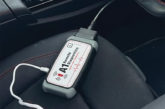Barry Babister from MOT Juice explores some of the guidance from the updated Testing Guide and focuses on the responsibility to manage your Test Quality Information (TQI).
Here is an extract from the Sixth Edition of the Testing Guide:
E3 Ongoing Requirements
5. Testers should access their Test Quality Information (TQI) Reports via the MOT Testing Service (MTS), to compare their personal performance with the national averages.
Let’s explore what the DVSA wants to achieve
The DVSA is accountable to Government for ensuring the MOT Scheme is well run and managed. The organisation itself cannot be in all places at all times, so by running a TQI comparison it is able to gain a structured insight on the performance of each and every MOT tester, to compare each individual MOT tester’s results against the national average, and to use this system to identify any anomalies. So the DVSA needs this information to prove it is managing the scheme and to identify where any weaknesses might be found.
How can the DVSA use the information?
As MOT testing stations, we previously had this data available via an earlier version of the VTS software, along with a scoring system. Now, just because we don’t see the scoring system please do not think for one moment that the DVSA cannot see your scores.
When a DVSA Vehicle Examiner (VE) is sat down the road from your garage he is able to look at the TQI of each tester and arrive at your reception area armed with what could be termed ‘insider information’, although the information that the DVSA can see is the same information you can access via your TQI.
Worse still, if your TQI percentages are consistently too far from the national average, a computer at ther DVSA could alert your local DVSA office and create the need for a Vehicle Examiner to visit your garage unannounced.
The DVSA has given us all the ability to be armed against any weaknesses in our TQI and, via the new directive, is actually forcing us to review and manage our own TQI. Let’s not forget the DVSA needs to have a well-run scheme, so by forcing us to review and manage the TQI the organisation is keeping itself in good shape too.
How often should I check my TQI?
The Sixth Edition Guide gives guidance on but speaking with DVSA and various VEs, the common expected regularity is monthly.
The frequency of checks may typically be expected to be one per tester every two months. However, this is based on the average garage throughput of two to three tests per day for experienced testers, so should be varied to reflect the volume of tests done or any other special circumstances – such as the experience of testers. For example, if a tester is inexperienced or doing twice the average amount of tests per day, you should consider increasing the checks to once a month.
What should I do with my TQI?
Each tester (not the employer or AE) should check their own TQI each month, and once you have your TQI report you should check your own averages against the national averages. If all of your TQI is within a percentage of the national average then you have very little to be concerned about, and the DVSA will also have no concerns here.
In order to remain compliant you should have a record of checking your TQI and be able to produce that record to the DVSA on demand.
What if my TQI is bad?
Two things could be at play here; on one hand, there is a valid reason for your TQI being bad, and on the other hand you are a bad tester and something more serious is happening.
What DVSA wants is the same across the entire scheme, and for this to become the mindset under which we all operate, so let’s get that out of the way first:
The DVSA wants to see that we all manage our Vehicle Testing Stations (VTS) correctly, and it expects us to do this by continually checking and measuring ourselves against a set of standards. Now the DVSA is not silly and it knows that there will be shortcomings and things that go wrong – in fact it expects just that. What the DVSA wants is for all of our checking to be recorded, then importantly it wants us to find things that are wrong and record them, and even more importantly it wants us to put those things right and record when they have been corrected.
So, returning to our bad TQI, it is safe to say that the DVSA will want to know that we have identified the issue and recorded that problem, and then we need to supply a solution and document that solutions outcome.
Finding a valid reason for your TQI differences is often down to unique circumstances. Some real-world examples that come to mind are:
■ MOT bays that only test very old vehicles, creating an average vehicle tested age outside national averages
■ A tester that is focused on retests at its site so does not see many failures
■ A garage that only tests let’s say three- year-old cars that have all been PDI inspected prior to test having virtually zero failures
■ A tester that has only conducted a very low number of tests does not balance well against the national averages
■ One tester being given all the worst and oldest vehicles
If you can identify a simple reason and record the findings then that should be sufficient, as long as next month things level out, for testers who do not test very often it is best to widen the time period to say six months and look again at the averages over a greater number of tests.
The alternative to genuine reasons above is an ongoing issue. If we assume that as a tester you are finding the same issue each month then you need to identify the areas you are having issues with and ask your AE or another tester to observe how you are testing the items that are causing concern, see if your testing methods are correct – can you improve the way you test? Are you failing or passing items correctly?
Whatever you find, you need to document your efforts to correct the issue, then so long as you can prove that you are working to correct the issue the DVSA will have little recourse. If you cannot correct and cannot identify valid reasons for your averages being very different to the national averages then you need to get extra training, and document that extra training.
It’s my Boss’ job, not mine!
WRONG!
The new directive makes a simple statement, as follows:
This is relevant to the tester as it is an ongoing requirement of authorisation.
This statement quite simply means that every tester is responsible for conducting their own TQI checks as part of their own authorisation to test. So if you are an MOT tester and you do not have a process for checking and recording your TQI, you are handing the DVSA a reason to remove your ability to test and potentially jeopardise your employment.
How can I report my TQI?
You can create an ‘easy to lose’ A4 sheet, print your TQI and comment on it, or maybe have an old-style ring binder and hope that everyone remembers to use it and keep it up- to-date.
Alternatively, you could use some MOT Compliance software that automates the majority of the task for you and helps you to record and rectify, and then allows the manager to track the ongoing compliance in real time ensuring full protection against DVSA.











